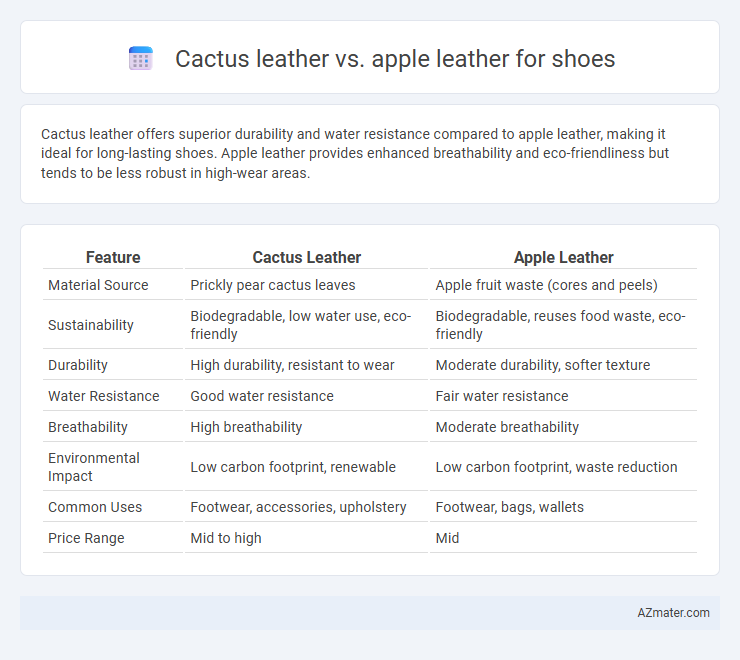Cactus leather offers superior durability and water resistance compared to apple leather, making it ideal for long-lasting shoes. Apple leather provides enhanced breathability and eco-friendliness but tends to be less robust in high-wear areas.
Table of Comparison
| Feature | Cactus Leather | Apple Leather |
|---|---|---|
| Material Source | Prickly pear cactus leaves | Apple fruit waste (cores and peels) |
| Sustainability | Biodegradable, low water use, eco-friendly | Biodegradable, reuses food waste, eco-friendly |
| Durability | High durability, resistant to wear | Moderate durability, softer texture |
| Water Resistance | Good water resistance | Fair water resistance |
| Breathability | High breathability | Moderate breathability |
| Environmental Impact | Low carbon footprint, renewable | Low carbon footprint, waste reduction |
| Common Uses | Footwear, accessories, upholstery | Footwear, bags, wallets |
| Price Range | Mid to high | Mid |
Introduction to Cactus Leather and Apple Leather
Cactus leather, derived from the mature leaves of the prickly pear cactus, offers a durable, eco-friendly alternative to traditional leather for shoes, emphasizing water efficiency and biodegradability. Apple leather is produced from apple waste, primarily apple peel and core residues, repurposed into a sustainable material celebrated for its softness and lightweight qualities in footwear. Both materials provide innovative, plant-based solutions that reduce environmental impact compared to conventional animal leather.
Origins and Production Processes
Cactus leather, derived primarily from the mature leaves of the Nopal cactus native to Mexico, undergoes a minimal water and chemical treatment process, emphasizing sustainability and biodegradability. Apple leather, created from the discarded apple peels and cores predominantly sourced from Italian fruit industries, is transformed through drying, grinding, and blending with polyurethane to achieve durability and flexibility. Both materials offer innovative, eco-friendly alternatives to traditional leather, with cactus leather leaning towards natural chemical-free processing and apple leather favoring composite manufacturing techniques.
Environmental Impact Comparison
Cactus leather requires significantly less water and generates fewer carbon emissions compared to apple leather, making it a more sustainable material choice for shoes. Apple leather production utilizes apple waste, reducing food industry byproducts, but its processing can involve more energy-intensive steps and chemical treatments. Overall, cactus leather's minimal resource use and biodegradability offer a lower environmental footprint in footwear manufacturing.
Material Durability and Performance
Cactus leather offers superior durability for shoes due to its dense fiber structure, providing excellent resistance to wear and tear compared to apple leather, which tends to be softer and less abrasion-resistant. Apple leather, made from processed apple waste, delivers moderate flexibility and breathability but may degrade faster under heavy use or moisture exposure. Both materials are sustainable alternatives to traditional leather, yet cactus leather's enhanced toughness ensures longer performance in footwear applications.
Comfort and Wearability
Cactus leather offers superior breathability and flexibility, enhancing comfort for extended wear, while apple leather provides a softer texture but may lack durability over long-term use. Shoes made from cactus leather typically maintain structural integrity and resist wear in various conditions, contributing to better overall wearability. Apple leather shoes prioritize a smooth feel but might require more frequent replacement due to faster material degradation under regular stress.
Design Versatility for Shoes
Cactus leather offers a highly flexible texture that adapts well to intricate shoe designs and embossing, making it ideal for high-fashion footwear requiring detailed craftsmanship. Apple leather provides a smoother, consistent surface that enhances minimalist and sleek shoe models, delivering an elegant and polished finish. Both materials support sustainable fashion trends with varied aesthetic options, but cactus leather often allows for greater experimentation in unique and bold designs.
Cost and Market Availability
Cactus leather generally commands a higher price due to its labor-intensive manufacturing process and limited production scale, whereas apple leather offers a more cost-effective alternative derived from apple waste, appealing to budget-conscious brands. Market availability for cactus leather remains niche and geographically restricted, primarily sourced from Mexico and select sustainable fashion brands, while apple leather benefits from wider accessibility and growing adoption, especially in Europe where apple processing industry byproducts are abundant. Both materials target eco-friendly footwear, but apple leather's lower cost and broader market presence position it as a more scalable option for mass-market shoe production.
Sustainability Certification and Ethics
Cactus leather, often certified by organizations like PETA and OEKO-TEX, emphasizes water efficiency and biodegradability, making it a sustainable choice for shoes. Apple leather is typically backed by certifications such as GOTS and FSC, highlighting its use of agricultural waste and commitment to reducing carbon footprint. Both materials promote vegan ethics, but cactus leather generally offers a stronger focus on minimizing environmental impact through lower water consumption and natural resource use.
Consumer Reviews and Brand Adoption
Consumer reviews highlight cactus leather's durability and eco-friendly appeal, often praising its natural texture and water resistance, which suits shoe applications well. Apple leather receives high marks for its softness and breathability, making it a preferred choice for comfortable, stylish footwear. Major brands like Veja and Adidas increasingly adopt cactus leather for sustainable collections, while apple leather gains traction with smaller, innovative brands focusing on vegan options.
Future Trends in Plant-Based Leathers
Cactus leather and apple leather are emerging as sustainable alternatives in the plant-based leather market for shoes, driven by increasing consumer demand for eco-friendly materials. Cactus leather offers durability and water resistance, while apple leather provides a softer texture and vibrant color retention, making both materials appealing for innovative footwear designs. Future trends indicate expanded adoption of these bio-leathers, supported by advancements in material processing and growing investment in circular fashion technologies.

Infographic: Cactus leather vs Apple leather for Shoe
 azmater.com
azmater.com